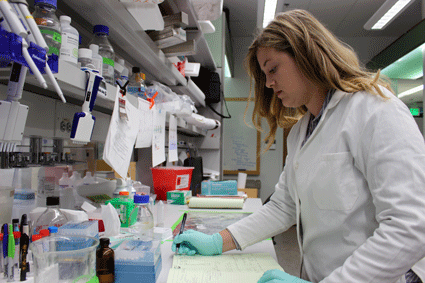Research has shown that preeclampsia in mothers is correlated with increased risk for children to be born with autism spectrum disorder, ADHD, learning deficits, and other cognitive dysfunctions.
While pursuing a doctoral degree at the University of Iowa, Serena (Banu) Gumusoglu and her lab colleagues hypothesized that developmental disorders could be traced to inflammation and dysfunction in pregnancy. They studied the embryonic brains of mice to gain a molecular understanding of what disrupts mechanisms in preeclampsia and other inflammatory exposures during pregnancy to result in developmental brain disorders and psychiatric conditions in offspring.
“I think it's really important to look at things during the prenatal period because it sets the stage for the rest of development,” Gumusoglu says. “If you're able to interact with the developing child in a proactive way, you can prevent some of these long-term effects that are really costly both emotionally for families and financially for health systems.”

Gumusoglu’s doctoral work in the lab of Dr. Hanna Stevens within the UI Hospitals and Clinics Department of Psychiatry and the Iowa Neuroscience Institute determined that inflammation and dysfunction during pregnancy—both in the placenta and in the mother—shapes offspring brain development and clarified potential treatment and prevention targets.
Gumusoglu received the prestigious Rex Montgomery Dissertation Prize, which recognizes the most meritorious dissertation by a doctoral student conducting research in prevention of disease and/or the translation of research into clinical practice. She received the award while working in the Psychiatry and Early Neurobiological Development Laboratory and is thankful to her mentor, Dr. Stevens, for her continued support.
“It's nice to feel that the work is recognized at this level given the peers that I have,” Gumusoglu says. “It's definitely representative of the program that nominated me—that I was able to perform at this level and do this work. The strength of the Neuroscience Program at the University of Iowa is what makes it such a destination program for people.”
Gumusoglu’s research piggybacked off previous studies conducted in the Santillan and Grobe Labs. The Santillan team had discovered via a mouse model that t-cells activated differently in preeclampsia. Gumusoglu and her colleagues built onto that knowledge, determining this inflammation was connected to fetal neurodevelopment.
In their preeclampsia mouse model, they saw changes in oxidative stress pathways in the placenta. The researchers concluded that these results may explain some of the neurodevelopmental abnormalities that they saw in the offspring brain.
The mice offspring affected by prenatal preeclampsia showed behavioral differences from control mice, and they also demonstrated changes in brain development, brain and regional volume size, packing of cells in the brain, and density of synapses.
They were also able to determine that multiple levels of disruption associated with the preeclampsia mouse model dovetailed with research conducted on humans by other labs. This led Gumusoglu to explore structural brain and behavioral differences in a mouse model of preeclampsia.
“As neurodevelopmental scientists, we want to implement these biomarkers in children, so when a baby is born or potentially before a baby is born we can determine whether the baby is at an increased risk for neurodevelopmental diseases,” Gumusoglu says. “The earlier you can intervene, the more you can change that disease trajectory.”
Tracing some of the observed differences in the brain and then correlating them with changes that occurred in the placenta suggested to Gumusoglu that there may be avenues for early intervention that can help mitigate disease risk and positively change the fetus’s developmental progress.
That said, Gumusoglu says there are a lack of sufficient, biologically driven treatments for these diseases. For example, there are no medications available for the core symptoms of autism. Using animals to model the observable expression of genetic traits in an environment allows for the study and manipulation of precise underlying mechanisms. Understanding these mechanisms is important because it allows scientists to develop more targeted treatments that are also relevant in people.
Postdoctoral work
Gumusoglu still believes that health across one’s lifespan matters. She also recognizes that systems need to be in place to make it easier for mothers to be healthy, such as early interventions, stress mitigation, and controlled blood pressure.
Now working for the Santillan Lab in the Department of Obstetrics and Gynecology at the University of Iowa, Gumusoglu continues to look at cellular and molecular mechanisms to really think about what needs to happen in women's health care to improve child outcomes. What she is learning from cellular, molecular, and mouse experiments can inform where to best shine the light in her field.
“I'm learning a lot more about … modeling aspects of maternal physiology in mice, and also working with human tissue, human samples, and human data to understand risk factors and increased susceptibility to gestational disorders like preeclampsia in women,” Gumusoglu says.
Right now, Gumusoglu is working through a chart review to try to understand neurodevelopmental risk factors in mothers treated at UI Hospitals and Clinics. She plans to take these findings and apply them to mouse models to better understand underlying mechanisms, such as serotonin dysregulation in pregnancy.
Gumusoglu plans to use her research at Iowa as a building block for future discoveries in preventative medicine, with the hope of culminating her educational and professional journey as a primary investigator in a lab of her own.